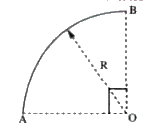A force ¯f=(ˆi−3ˆj+2ˆk)N moves a particle from ¯r1=2ˆi+7ˆj+4ˆk)m to (¯r2=(5ˆi+2ˆj+8ˆk)m. The work done by the force is Solution in Telugu
18J
28J
38J
48J
The correct Answer is:C
Step by step video, text & image solution for A force barf=(hati-3hatj+2hatk)N moves a particle from bar r_(1)=2hati+7hatj+4hatk)m to (barr_(2)=(5hati+2hatj+8hatk)m. The work done by the force is by Physics experts to help you in doubts & scoring excellent marks in Class 11 exams.
Updated on:21/07/2023Topper's Solved these Questions
- WORK -POWER-ENERGYBOOK - AAKASH SERIESCHAPTER - WORK -POWER-ENERGYEXERCISE - LECTURE SHEET (EXERCISE-I WORKDONE BY FORCE MORE THAN ONE CORRECT ANSWER TYPE QUESTIONS)
2 Videos
- WORK -POWER-ENERGYBOOK - AAKASH SERIESCHAPTER - WORK -POWER-ENERGYEXERCISE - LECTURE SHEET (EXERCISE-I WORKDONE BY FORCE LINKED COMPREHENSION TYPE QUESTIONS)
2 Videos
- VISCOSITY BOOK - AAKASH SERIESCHAPTER - VISCOSITY EXERCISE - Questions for Descriptive Answers
3 Videos
- WORK POWER ENERGYBOOK - AAKASH SERIESCHAPTER - WORK POWER ENERGYEXERCISE - EXERCISE - 3
61 Videos
Similar Questions
A constant force F acts on a moving body along a smooth quarter circular arc of radius R fixed on horizontal surface. Calculate the work done by force F from A to B

View SolutionA block of mass 2.5 kg is pushed 2.2. m along a frictionless horizontal table by a constant 16 N force directed 45∘ above the horizontal. Then
Workdone by the applied force is
View SolutionAn iron sphere of mass 20×10−3 kg falls through a viscous liquid with terminal velocity 0.5 m/sec. Find the terminal velocity of another iron sphere of mass 54×10−2 kg.
View SolutionIf →A+→B=→Rand2→A+→B is perpendicular to →B then
View SolutionTwo constant forces F1=2ˆi−3ˆj+3ˆk(N) and F2=ˆi+ˆj−2ˆk(N) act on a body and displace it from the position r1=ˆi+2ˆj−2ˆk(m) to the position r2=7ˆi+10ˆj+5ˆk(m). What is the work done
View SolutionTwo forces f1=3ˆi−2ˆj+ˆkandf2=ˆi+3ˆj−5ˆk acting on a particle at A move it to B. find the work done if the position vector of A and B are −2ˆi+5ˆkand3ˆi−7ˆj+2ˆk.
View SolutionA constant force of (2ˆi+3ˆj+5ˆk) N produces a displacement of (3ˆi+2ˆj+2ˆk) m. Then work done is
View Solutionनियत बल →F=5ˆi+5ˆj के अधीन एक कण बिंदु →r1=2ˆi+3ˆj →r2=3ˆi+2ˆj से तक गति करता है । बल द्वारा किये गये कार्य की गणना कीजिए ।
View SolutionA force →F=(2ˆi+3ˆj+4ˆk)N displaces a body from position vector →r1=(2ˆi+3ˆj+ˆk)m to the positive vector →r2=(ˆi+ˆj+ˆk)m. Find the work done by this force.
View SolutionThe work done by the force →F=2ˆi−3ˆj+2ˆk in moving a particle from (3, 4, 5) to (1, 2, 3) is :
View SolutionA uniform force of (2ˆi+ˆj) N acts on a particle of mass 1 kg. The particle displaces from position (3ˆj+ˆk) m to (5ˆi+3ˆj) m. The work done by the force on the particle is
View SolutionA uniform force of (2ˆi+ˆj) N acts on a particle of mass 1 kg. The particle displaces from position (3ˆj+ˆk) m to (5ˆi+3ˆj) m. The work done by the force on the particle is
View SolutionA force →F=(5ˆi+3ˆj+2ˆk)N acts on a particle , and the particle moves from the origin to a point →r=(2ˆi−ˆj)m.
what will be the work done on the particle ?
View SolutionA constant force →F=2ˆi−ˆj−ˆk moves a particle from position vector
→r1=−5ˆi−4ˆj+ˆk to position vector →r2=−7ˆi−2ˆj+2ˆk . What will be the work done by this force ?
View Solutionकोई बल F=5ˆi−4ˆj+2ˆk,r1=2ˆi+7ˆj+4ˆk, से r2=−5ˆi+2ˆj+3ˆk तक लगता है, तब किया गया कार्य है
View Solution
